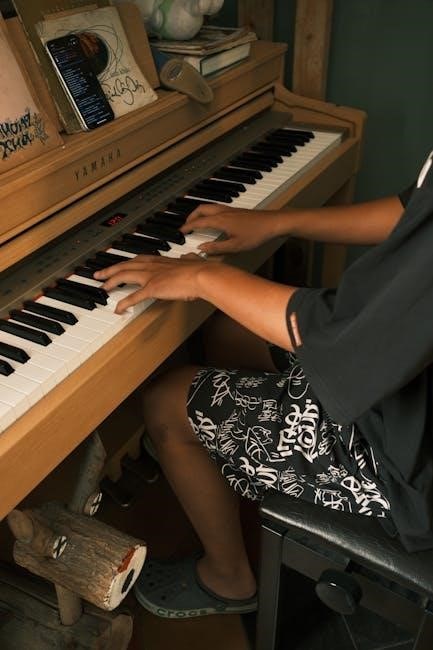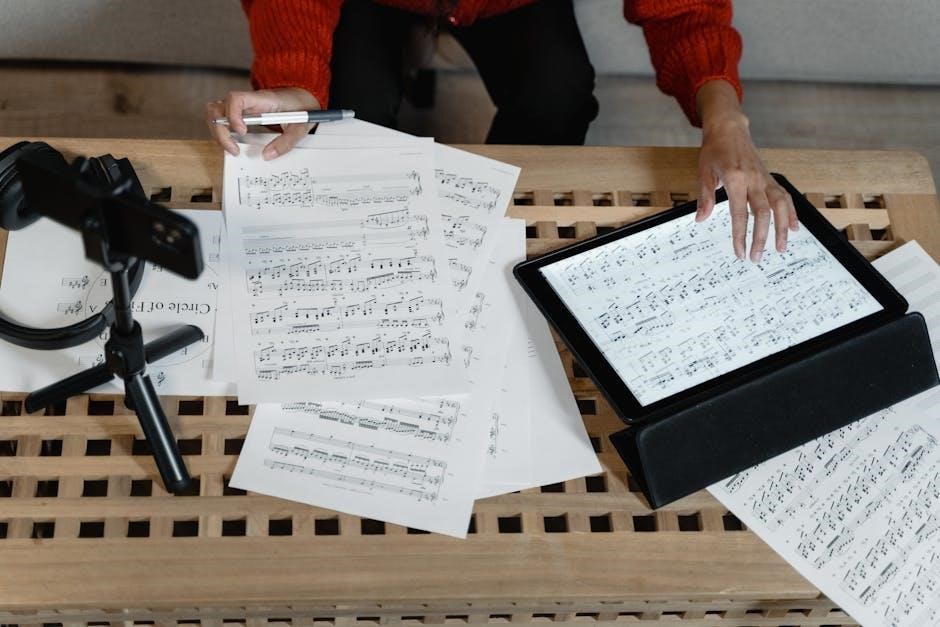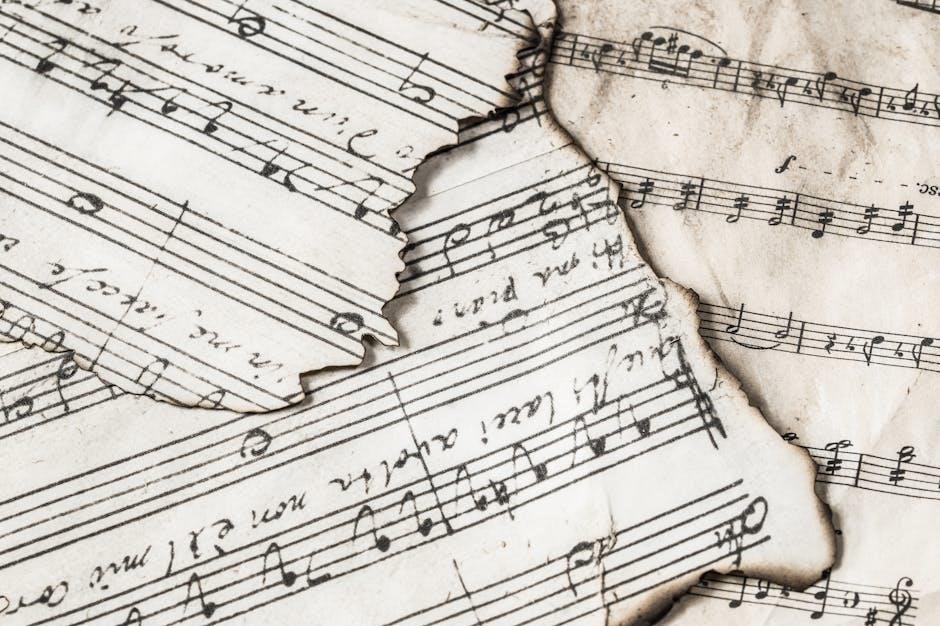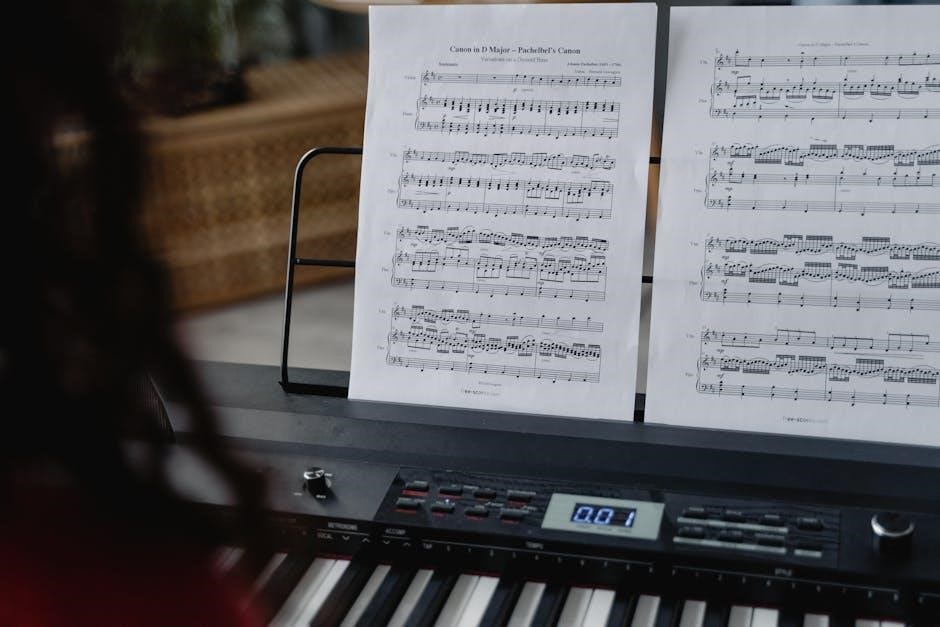“Moon River” is a timeless classic from Breakfast at Tiffany’s, composed by Henry Mancini with lyrics by Johnny Mercer․ Its haunting melody and emotional depth make it a beloved piece for pianists of all levels, offering a rich musical experience that combines elegance with simplicity․
1․1 Historical Background of “Moon River”
“Moon River” is a timeless melody composed by Henry Mancini, with lyrics by Johnny Mercer, for the 1961 film Breakfast at Tiffany’s․ The song gained immediate acclaim, winning the Academy Award for Best Original Song in 1962․ It has since become a cultural icon, symbolizing romance and longing․ Originally performed by Audrey Hepburn in the film, “Moon River” has been covered by numerous artists, solidifying its place in music history․ Its elegant and haunting melody makes it a favorite among pianists, with sheet music arrangements catering to both beginners and advanced players․ The song’s enduring popularity has led to its adaptation into various styles, ensuring its relevance across generations․
1․2 Importance of Sheet Music in Learning “Moon River” for Piano
Sheet music is essential for mastering “Moon River” on the piano, as it provides a clear guide to the melody, harmony, and structure of the piece․ For beginners, it offers a visual representation of notes, helping them understand timing and dynamics․ Experienced players can use it to explore intricate arrangements and nuances․ The sheet music ensures accuracy, allowing pianists to capture the song’s emotional depth and complexity․ It also serves as a reference for proper finger placement and pedaling techniques․ With “Moon River” being a beloved standard, having high-quality sheet music is crucial for both practice and performance, enabling pianists to bring this timeless melody to life with precision and expression․

Popular Versions and Arrangements of “Moon River” Sheet Music

Explore various arrangements, from easy piano versions for beginners to advanced transcriptions, including jazz and cocktail piano styles, all available as downloadable PDFs online․
2․1 The Original Version by Henry Mancini
Henry Mancini’s original composition of Moon River is a timeless masterpiece, famously performed by Audrey Hepburn in Breakfast at Tiffany’s․ The sheet music reflects Mancini’s elegant arrangement, with a simple yet haunting melody that captures the song’s emotional depth․ The original version features a moderate tempo, flowing arpeggios, and a iconic flute intro transcribed for piano․ Dynamics are subtle, with soft crescendos that build tension․ For pianists, the PDF sheet music preserves the original key and structure, making it accessible while maintaining its sophisticated charm․ This version is ideal for those seeking an authentic interpretation, allowing pianists to connect with the song’s nostalgic beauty․ Its timeless appeal continues to inspire musicians worldwide․
2․2 Easy Piano Arrangements for Beginners
For pianists just starting out, easy piano arrangements of Moon River simplify the iconic melody and harmony, making it accessible while preserving its beauty․ These versions often feature a slower tempo and reduced complexity, focusing on the core melody and basic chord progressions․ Simplified dynamics and fingerings help beginners master the piece without frustration․ Many educational sheet music publishers offer these arrangements, ensuring that new players can enjoy the song’s timeless appeal․ Additionally, some PDF versions include markings or guides to help with hand positioning and rhythm․ These arrangements are perfect for building confidence and developing technique while connecting with the song’s emotional essence․ They serve as an excellent introduction to more advanced versions as skills improve․
2․3 Advanced Piano Arrangements for Experienced Players
Advanced piano arrangements of “Moon River” are tailored for experienced pianists who desire a more challenging and nuanced interpretation․ These arrangements typically include intricate fingerings, complex harmonies, and varied dynamics that demand a higher level of technical skill․ They may incorporate extended techniques such as arpeggios, runs, and chordal variations, which enhance the musicality and emotional depth of the piece․ Additionally, these arrangements often feature varied tempos, expressive phrasing, and detailed pedaling instructions, allowing for a more personalized and interpretative performance․ For skilled musicians, these versions provide an excellent opportunity to refine their technique and add a unique touch to the timeless melody․ Furthermore, these advanced arrangements are often available in specialized sheet music editions or on premium platforms that cater specifically to the needs of accomplished pianists․ Some publishers also offer digital versions with interactive features, enabling players to explore different interpretations and practice effectively․

2․4 Jazz and Cocktail Piano Arrangements
Jazz and cocktail piano arrangements of “Moon River” offer a sophisticated and improvisational twist to the classic melody․ These versions are designed to evoke the elegance of jazz standards, often incorporating syncopated rhythms, extended chords, and intricate harmonies․ Cocktail piano arrangements, in particular, emphasize a smooth, flowing style, making them perfect for intimate settings or professional performances․ Many jazz interpretations include improvisational sections, allowing pianists to add their own creative flair․ These arrangements are ideal for those who enjoy blending traditional melodies with modern jazz influences․ They are widely available in sheet music PDFs, with both free and paid versions accessible online, catering to pianists who appreciate a more refined and dynamic approach to the timeless song․
2․5 Transcriptions and Covers by Famous Pianists
Transcriptions and covers of “Moon River” by famous pianists offer unique interpretations that showcase the song’s versatility․ Many renowned pianists, such as Oscar Peterson and Bill Evans, have created their own renditions, blending jazz harmonies and intricate techniques․ These arrangements often feature complex improvisations, sophisticated chord voicings, and expressive phrasing․ Some pianists, like Lang Lang, have even performed virtuosic versions, adding a classical twist․ These transcriptions are highly sought after by pianists looking to expand their repertoire․ They are available as sheet music PDFs, both in free and paid formats, allowing pianists to study and perform these iconic interpretations․ These covers highlight the timeless appeal of “Moon River” and its ability to inspire artistic reinvention․

Where to Find “Moon River” Sheet Music PDF for Piano
Find “Moon River” sheet music PDF for piano on various online platforms, including free sheet music websites, paid platforms, and community-generated scores with diverse arrangements․
3․1 Free Sheet Music Websites
Free sheet music websites offer accessible versions of “Moon River” for piano, ideal for beginners or those exploring the piece․ Websites like MuseScore, Sheet Music Archive, and Musicnotes often provide complimentary arrangements․ These platforms may include simplified or transcribed versions, enabling pianists to practice without cost․ Some sites also feature user-contributed scores, offering diverse interpretations․ While free versions may lack the detail of professional editions, they provide a great starting point for learning․ Always verify the legality and quality of free downloads to ensure accuracy and compliance with copyright laws․
- MuseScore: Offers a variety of user-uploaded arrangements․
- Sheet Music Archive: Provides classic and modern scores․
- Musicnotes: Features free samples and previews of popular songs․
These resources are excellent for initial exploration or educational purposes․
3․2 Paid Sheet Music Platforms
Paid sheet music platforms offer high-quality, professionally arranged versions of “Moon River” for piano․ Websites like Musicnotes, Sheet Music Plus, and MuseScore Pro provide accurate and detailed scores․ These platforms often include features like interactive previews, MIDI files, and adjustable tempos․ Paid versions ensure legality and support artists, offering precise notation and arrangements tailored for various skill levels․ They are ideal for serious learners seeking authentic or enhanced versions of the piece․ Some platforms also offer jazz or orchestral arrangements, expanding musical possibilities․
- Musicnotes: High-quality, legally licensed sheet music with previews․
- Sheet Music Plus: Extensive library with diverse arrangements․
- MuseScore Pro: Premium access to exclusive scores and tools․
3․3 Community-Generated Scores and Arrangements
Community-generated scores and arrangements of “Moon River” offer unique interpretations and adaptations by pianists and enthusiasts․ Platforms like MuseScore, Scribd, and Reddit host user-created sheet music, often for free or through collaborative sharing․ These arrangements may include simplified versions, jazz improvisations, or even duet adaptations․ While quality can vary, they provide fresh perspectives and creative twists on the classic piece․ Some creators share their arrangements for educational purposes, fostering a sense of community among musicians․ However, be cautious of copyright compliance and ensure the arrangements are legally shared․
- MuseScore: A hub for user-generated sheet music with diverse arrangements․
- Scribd: A platform where users share and discover unique scores․
- Reddit: Communities like r/piano share and discuss fan-made arrangements․

Key Features of “Moon River” Piano Sheet Music
The sheet music features a haunting melody, lush harmonies, and timeless chord progressions․ It includes dynamic markings and tempo indications, capturing the song’s emotional depth and beauty․
4․1 Melody and Harmony Structure
The sheet music for “Moon River” features a timeless melody that flows effortlessly, supported by lush harmonies․ The melody is presented clearly, with a focus on legato playing to emphasize its emotive qualities․ Harmonically, the piece uses extended chords and inversions to create a rich, cinematic sound․ The interplay between the melody and harmony is intricate, with the harmony often mirroring the melodic line to enhance depth․ The notation includes detailed markings for dynamics and articulation, guiding pianists to capture the song’s nostalgic and dreamy essence․ The structure is well-suited for piano, allowing for expressive interpretations while maintaining the original’s elegance and charm․
4․2 Chord Progressions and Dynamics
The sheet music for “Moon River” features intricate chord progressions that add depth and emotion to the melody․ The harmonies are built on extended chords, including major, minor, and diminished chords, which create a lush, cinematic quality․ Dynamics play a crucial role, with subtle shifts from pianissimo to mezzo-piano and mezzo-forte, guiding the pianist to convey the song’s nostalgic and dreamy atmosphere․ The notation includes detailed dynamic markings, such as crescendos and decrescendos, to help shape the performance․ The interplay between chord voicings and dynamics allows for expressive interpretation, making the piece both challenging and rewarding to play․ These elements work together to bring out the timeless beauty of “Moon River” on the piano․
4․3 Tempo and Timing Considerations
Mastering the tempo and timing of “Moon River” is essential for capturing its haunting beauty․ The sheet music typically indicates a moderate tempo, often around 66-76 BPM, allowing for a graceful, flowing performance․ The 4/4 time signature provides a steady framework, but subtle rubato and phrasing nuances can enhance emotional expression․ Dynamics and articulations, such as legato and staccato markings, further refine the timing․ Paying attention to fermata pauses and ritardando sections is crucial for dramatic effect․ Slight variations in tempo can personalize the performance while maintaining the song’s timeless charm․ Accurate timing ensures the melody remains clear and the harmony supportive, making “Moon River” a joy to play and listen to․

Tips for Playing “Moon River” on the Piano
Focus on the melody to highlight its timeless elegance․ Play with a steady, moderate tempo and use legato for smooth transitions․ Emphasize emotional expression through dynamics․
5․1 Focusing on the Melody
Mastering the melody of “Moon River” is essential for capturing its timeless elegance․ Begin by practicing the melody separately from the accompaniment to ensure clarity and precision․ Use a metronome to maintain a steady, moderate tempo, allowing the melody to flow naturally․ Employ legato playing to create smooth transitions between notes, which enhances the song’s emotional depth․ Pay attention to dynamics, playing softer passages with delicacy and slightly louder ones with controlled emphasis․ This approach will help you convey the melody’s beauty and emotional resonance effectively․ Additionally, listening to professional recordings can provide inspiration and guidance for your interpretation․
5․2 Voicing and Dynamics
Proper voicing and dynamics are crucial for a captivating performance of “Moon River․” Focus on bringing out the melody with a clear, singing tone, while subtly shading harmonic accompaniments․ Use dynamics to enhance emotional expression, with soft passages played delicately and crescendos building gently․ Pay attention to balance between the hands, ensuring the right-hand melody remains prominent; Experiment with chord voicings, emphasizing key notes to add depth without muddying the sound․ Dynamics should follow the natural rise and fall of the melody, creating a sense of storytelling․ Practice varying touch and intensity to convey the song’s introspective and romantic qualities, making each performance feel heartfelt and engaging․
5․3 Wrist Movement and Technique
Mastering wrist movement and technique is essential for a smooth, expressive performance of “Moon River․” Use a relaxed wrist position to maintain fluidity, especially in the song’s flowing arpeggios and chord progressions․ Employ wrist rotation to achieve a rich, resonant sound, particularly in the lower registers․ For delicate passages, keep your wrists soft and flexible to produce a light, airy texture․ Practice glissando and legato techniques to connect notes seamlessly, enhancing the song’s dreamy quality․ Pay attention to dynamics; use controlled wrist movements to modulate volume without sacrificing tone․ Regular exercises like finger stretches and wrist circles can improve dexterity and prevent fatigue․ By refining your technique, you’ll capture the elegance and emotion of “Moon River” with ease and precision․

Tutorials and Resources for Learning “Moon River”
Explore video tutorials on YouTube and piano learning apps like Piano Nanny or HDpiano․ Utilize MIDI files and practice software like Synthesia for hands-free learning․ Interactive tools like flat․io and NoteFlight offer customizable practice sessions․
6․1 Video Tutorials and Lessons
Video tutorials are an excellent resource for mastering “Moon River” on the piano․ Platforms like YouTube offer a wide range of lessons, from beginner-friendly breakdowns to advanced interpretations․ Many channels, such as Piano Nanny and HDpiano, provide step-by-step guides, focusing on melody, chords, and nuanced techniques․ These tutorials often cater to different skill levels, ensuring that both novices and experienced pianists can benefit․ Some instructors emphasize classical methods, while others incorporate contemporary styles or jazz improvisation․ Additionally, video lessons allow learners to observe finger placement, dynamics, and tempo in real-time, making the learning process more engaging and accessible․ Utilizing these resources can significantly enhance your understanding and performance of “Moon River․”
6․2 MIDI and MP3 Accompaniments

MIDI and MP3 accompaniments are invaluable tools for practicing and performing “Moon River․” MIDI files allow pianists to adjust tempo, isolate parts, and practice with a virtual piano accompaniment․ MP3 files provide high-quality audio for listening and playing along, helping musicians refine their timing and dynamics․ Websites like Musicnotes and SheetMusicPlus offer these resources, enabling learners to immerse themselves in the piece․ These accompaniments are especially useful for understanding the song’s rhythm and harmony․ By practicing with MIDI and MP3 files, pianists can develop a stronger connection to the music and enhance their overall performance․ These resources cater to both beginners and advanced players, offering flexibility and depth to the learning process․
6․3 Interactive Tools for Practice
Interactive tools offer a dynamic way to practice “Moon River” on the piano․ Software like Synthesia or Piano Maestro provides visual aids, displaying notes in real time and allowing pianists to slow down or loop sections․ Web-based platforms enable users to upload sheet music and practice with interactive scores, highlighting tricky passages․ Apps like Tempo or Time Trainer help pianists master the song’s tempo and timing․ These tools also offer real-time feedback, improving accuracy and technique․ For beginners, interactive tools simplify learning by breaking the piece into manageable parts․ Advanced players can refine nuances like dynamics and articulation․ These resources make practice engaging and effective, catering to all skill levels and enhancing overall performance quality․ They are indispensable for achieving a polished rendition of “Moon River․”

Cultural and Musical Significance of “Moon River”
“Moon River” is a timeless classic, iconic for its role in Breakfast at Tiffany’s․ Its melody and lyrics evoke deep emotion, resonating universally․ The song has won numerous awards, solidifying its place in music history and pop culture, inspiring countless interpretations and arrangements for piano and other instruments, making it a beloved standard across generations and musical genres, while its cultural impact continues to grow, ensuring its lasting legacy as a masterpiece of 20th-century music․ Its enduring appeal lies in its ability to connect with audiences on a profound level, making it a cherished piece for pianists and music enthusiasts alike, forever celebrated for its beauty and emotional depth․
7․1 The Song’s Role in “Breakfast at Tiffany’s”
“Moon River” was famously featured in the 1961 film Breakfast at Tiffany’s, where it was performed by Audrey Hepburn․ The song’s melancholic melody and poignant lyrics perfectly complemented the film’s narrative, capturing the essence of Holly Golightly’s character․ Its inclusion in the movie not only elevated the film’s emotional impact but also cemented the song’s status as a cultural icon․ The scene where Hepburn sings “Moon River” while strumming a guitar became one of the most memorable moments in cinematic history․ The song’s timeless appeal was further underscored by its Academy Award for Best Original Song, solidifying its legacy in both film and music․ This association has made “Moon River” a beloved piece for pianists to interpret and perform, connecting it deeply to the film’s enduring charm․ Its presence in Breakfast at Tiffany’s continues to inspire artistic adaptations, ensuring its relevance across generations․
7․2 Legacy and Popularity Over the Years
“Moon River” has endured as a timeless classic, its popularity spanning generations․ Since its debut in Breakfast at Tiffany’s, the song has been covered by countless artists, including Frank Sinatra, Ella Fitzgerald, and Andy Williams, each adding their unique interpretation․ Its hauntingly beautiful melody and poignant lyrics resonate deeply, making it a staple in popular culture․ The sheet music for piano remains widely sought after, appealing to both beginners and advanced players․ Over the years, “Moon River” has been adapted into various genres, from jazz to classical, further cementing its legacy․ Its versatility and emotional depth continue to inspire new arrangements and performances, ensuring its place as one of the most cherished songs of the 20th century․ Its lasting impact is a testament to its universal appeal and enduring beauty;
“Moon River” sheet music for piano offers a timeless musical experience, blending elegance and emotion․ Its accessibility for all skill levels ensures its enduring popularity among pianists worldwide․
8․1 Final Thoughts on Learning and Performing “Moon River”
Learning and performing “Moon River” is a rewarding journey that connects pianists with its timeless elegance and emotional depth․ The sheet music offers versatility, catering to both beginners and advanced players․ By mastering the melody, dynamics, and tempo, pianists can capture the song’s essence․ Emphasize expressive phrasing and subtle pedaling to convey its haunting beauty․ For beginners, starting with simplified arrangements builds confidence, while advanced pianists can explore complex harmonies and improvisations․ Regardless of skill level, “Moon River” remains a cherished piece that resonates deeply with audiences, making it a valuable addition to any pianist’s repertoire․
8․2 Encouragement to Explore More Sheet Music
Exploring more sheet music beyond “Moon River” can deepen your musical journey and broaden your skills․ Discovering diverse genres and styles, from classical masterpieces to modern compositions, enriches your understanding of music and enhances your technique․ Consider exploring works by other iconic composers or delving into jazz standards, which offer unique challenges and creative expression․ Engaging with a wide range of repertoire fosters growth as a pianist and keeps your practice fresh and exciting․ Joining forums or communities of pianists can also inspire you to try new pieces․ Embrace the adventure of learning and performing different music to continuously evolve as a musician․
